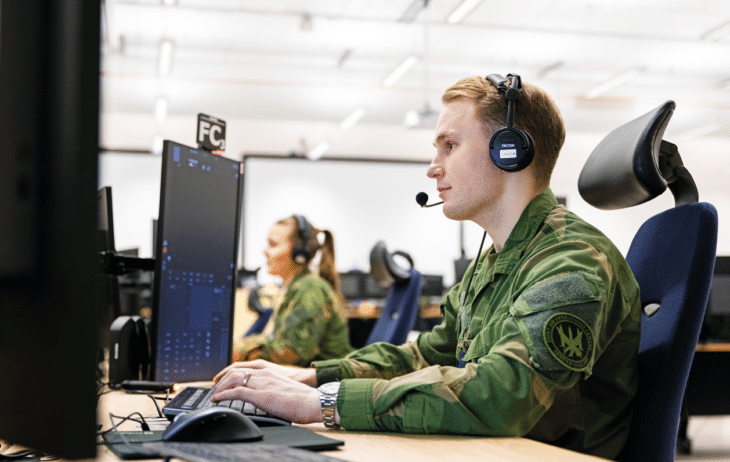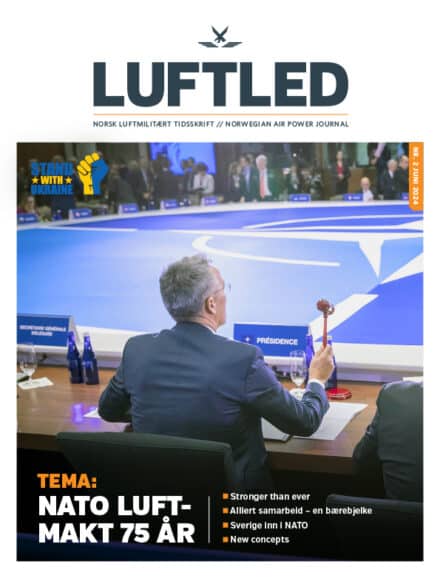New concepts for modern warfare
The Norwegian Air Force has been forward-leaning since its origins and throughout its 75-year history as a NATO force. It has taken advantage of new technology, innovative thinking, and concepts. We are now bringing the RNoAF to the next stage of what new technology and new doctrines allow us to do in modern warfare.

Innovations in both civilian and military technologies, novel applications and emerging doctrines are changing the characteristics of how modern warfare is conducted.1 Rapid introduction of robotics with differing levels of autonomy and Artificial Intelligence (AI)2, combined with proliferation of military grade and improvised commercial-off-the-shelf (COTS) based long-range precision munition and democratisation of space, will cause a paradigm shift toward more autonomous operations in increasingly more complex and contested battlefield environments where traditional safe havens are diminishing rapidly. Victory under these modern warfare conditions demands a shift towards increased and more advanced integration and synchronisation of military efforts across all domains. Acknowledging this development, the Royal Norwegian Air Force (RNoAF) established a Joint Air Operations Centre (JAOC) as of 1 January 2024. JAOC will seek to exploit the array of available weapons systems more effectively and lead air operations in support of all domains.
Strategic context and Nordic collaboration
The above-mentioned contemporary shift in warfighting trends coincide with the establishment of a third NATO Joint Force Command (JFC) as well as Finland’s and Sweden’s accession into NATO. These overall changes significantly alter the strategic High North theatre, allowing novel opportunities to reinvent our close operational partnership across the Nordic countries. Therefore, as a first step towards more effective integration and coordination between our air forces, the Nordic Air Chiefs have approved a Nordic Air Power Concept where integrated air command and control (Air C2) is a defined line of effort. In addition, NATO will establish an Air C2 node in support of JFC Norfolk (JFCNF), slated for initial operating capability (IOC) on 1 January 2025. The Nordic Chiefs of Defence (CHODs) have suggested that this Air C2 entity will be located in Norway. If approved by NATO, JAOC will be nominated as the core, or nucleus, of a Combined Joint Air Operations Centre – North (CJAOC-N), fulfilling the Air C2 requirements for both AIRCOM Ramstein and JFCNF.
Crossing domains
Recognizing this responsibility along with the urgent need to improve the RNoAF Air C2 organization, it is imperative that the RNoAF adapt a Joint All-Domain Command and Control (JADC2) mindset and embrace Joint All-Domain Operations (JADO) as its modus operandi. The purpose of this article is to create a common understanding as well as to inspire and direct necessary development for the RNoAF organization and all its airmen. The article will first explain the purpose (why), then provide definitions (what), followed by a presentation of lines of effort (how). Finally, the article will dictate action items (how, where, when).
Victory under modern warfare conditions demands a shift towards increased and more advanced integration and synchronisation of military efforts across all domains
Defining JADC2 and JADO
Let´s talk definitions. JADC2 is an advanced C2 framework supporting JADO with the intent of linking sensors, weapons, and data seamlessly across domains and operating environments such as the Electromagnetic Spectrum (EMS). It seeks to enable swift decision-making and coordination, providing commanders with comprehensive situational awareness that can be exploited for strategic effects and advantage.
JADO is the method of integrating planning, execution, and control across air, land, sea, space, and cyber domains, emphasising interoperability and flexibility in response to security challenges. JADO maximises and combines the unique strengths of each domain for more effective operations.
While JADO is about the approach to conducting operations across domains, JADC2 provides the C2 architecture necessary to support and enable these integrated operations. JADC2 is, in essence, the enabler that seamlessly allows JADO to be effectively implemented.
How do we get there?
As first step towards a transition to JADC2, we will unify the RNoAF operational C2 structure under one commander, in a Joint Air Operations Centre (JAOC). Secondly, and closely related, the RNoAF will optimise how it executes modern all-domain control by standing up Aerospace Battle Management (ABM) as the main principle of the JAOC. ABM marks a fundamental transition towards a level of operational information sharing, distributed control, delegation of authority, and decentralised execution appropriate for the modern battlefield requirements. This shift will enable faster decision making with improved quality through designated conditions-based delegation of authorities, ensuring C2 to function also in contested environments.3 Third, to enable JADC2 and empower the Air C2, RNoAF Air Command Control Communication Computing Information Systems (AIRC4IS) will be augmented by next generation technology and solutions that will initiate a path towards operationally improved Advanced Battle Management Systems (ABMS). JADC2 requires effective information exchange requirement, processing and sharing across multiple domains.
The plan
The RNoAF’s strategy for JADC2 and JADO will progress and advance along three lines of effort4 (LOEs): (1) Improve Organisation and Processes for Information Sharing, (2) Modernise Connectivity, and (3) Cultivate Warfighter Attitude:
- Improve Organisation and Processes for Information Sharing (process and organisation) by enabling and encouraging (mindset) cross-domain and cross-service flow of actionable information at all warfighter levels.
- Modernise Connectivity (technology) by improving our AIR C4IS structure and capability to distribute information more effectively across open standards and domains and improve systems between the warfighters and the tactical battlespace management functions (TBMF).
- Cultivate Warfighter Attitude (culture) by fostering and taking advantage of our strongest comparable military service strengths: Mission Command (MC) – a culture for centralised command, distributed control and decentralised execution. Through high level of trust, shared situational awareness and understanding of commander’s intent, we use mission-type orders to delegate authority and empower subordinates to retain the operational initiative at all levels, also in contested and denied environments.5
In sum, these LOEs will transform RNoAF into a JADO oriented organisation.
Action items
The following key actions will move RNoAF towards JADC2 and JADO in the short timeframe. Unless specified otherwise, all tasks are due no later than 15 JUN 2025:
1) Improve Organisation and Processes for Information Sharing
a) Establish and further develop the Integrated Tasking Order6 (ITO) as an authoritative JAOC order product.
b) Establish a tiger team at JAOC to modernise and automate parts of the Air Tasking Cycle, including the use of AI assistance.
c) Establish a tiger team to identify improvements in cross-domain integration throughout the joint targeting and assessment cycle, including use of AI assistance.
d) Develop a food-for-though (FFT) paper for integration of accessible space-based sensors aimed at improving RNoAF ISR processes and mission effectiveness.
e) Establish a tiger team at JAOC to introduce and test means to automate Recognised Air Picture (RAP) track identification.
f) Establish a tiger team at JAOC to develop and implement an ABM concept.
g) Establish a coordinating element (liaison) to NOR Space Command/NSpOC focusing on shared insights and improved JADC2/JADO collaboration.
h) Establish an Air Combat Lab at 132 Air Wing Ørland.
i) Establish an Electromagnetic Battle Management (EMB) staff that deconflicts across Electromagnetic Warfare (EW), Navigation Warfare (NAVWAR), Position, Navigation, Timing (PNT), Battlefield Spectrum Management (BSM) and Signal Intelligence (SIGINT) in order to ensure operations phase optimalisation of Electromagnetic Spectrum (EMS) exploitation.
2) Modernise Connectivity
a) Nominate JAOC as lead unit in implementing a modern next generation AIR C4IS infrastructure that enables and facilitates agile use of modern airpower at the speed of relevance in JADO. The RNoAF Air Staff will implement an AIR C4IS infrastructure with relevant applications that is compatible with NATO and allied partners through federated CIS networks in line with RNoAF CIS concept7 and Norwegian national CIS concept8. Development from 2025 will include updated AIR C4IS on all RNoAF air wings.
b) RNoAF briefings will use modern automated Community of Interest (COI) services as the primary briefing tool to maximum extent.
c) Establish a tiger team at RNoAF Air Staff to explore the possibility for the RNoAF to be a constructive partner in developing space-to-ground based link9 connectivity in an Arctic environment.
d) The Air Warfare Centre (AWC) will ensure that RNoAF requirements in acquisition and development processes guarantees that weapon system protocols are interoperable with both national forces and forces of close allies.
e) Establish a tiger team at JAOC to modernise the targeting cycle using modern automated COI.
3) Cultivating Warfighter Attitude
a) AWC will develop a comprehensive training program for ABM students and Air C2 students on JADC2/JADO Mission Command and MTO.
b) Chief of RNoAF’s Strategy Group10 will update The Norwegian Armed Forces Doctrine for Air Operations11 and RNoAF Air Operations Planning Handbook12 to include new domains (space and cyber), focusing on JADC2 and JADO, revisiting the principles of centralised command, distributed control and decentralised execution as described in RNoAF Capstone Doctrine.
c) AWC will ensure that decision-making and operational and strategic thinking is an integral part of all formal education for RNoAF officers and specialists.
d) JAOC will implement JADC2 into exercises that require integration and synchronisation across domains with high tempo using Integrated Task Orders (ITO).
e) Challenge the RNoAF junior specialists’ innovation council on ideas and actions on how to foster a culture of innovation and continuous learning, encouraging RNoAF junior personnel to develop new solutions to JADC2/JADO challenges.
f) Chief of RNoAF’s Strategy Group will create JADC2 and JADO briefings and articles for various types of Norwegian and Nordic military journals and webpages.





